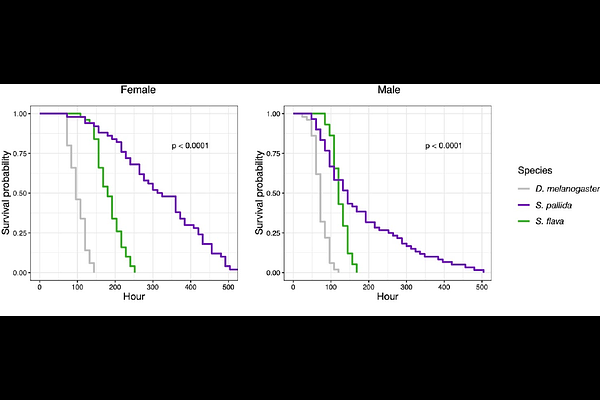Alternative Splicing in TRPA1 Drives Sensory Adaptation to Electrophiles in Drosophilids

Alternative Splicing in TRPA1 Drives Sensory Adaptation to Electrophiles in Drosophilids
Suzuki, H. C.; Saito, C. T.; Rajshekar, S.; Sokabe, T.; Haji, D.; Groen, S. C.; Pelaez, J. N.; Matsunaga, T.; Takemoto, A. S.; Tanaka, K. M.; Takahashi, A.; Tominaga, M.; Saito, S.; Whiteman, N. K.
AbstractBehaviors are among the first traits to evolve as animals enter new niches, but their molecular bases are poorly understood. To address this gap, we used the mustard-feeding drosophilid fly Scaptomyza flava, which feeds on toxic Brassicales plants like wasabi that produce noxious, electrophilic isothiocyanates (ITCs or mustard oils). We found that S. flava exhibits dramatically reduced behavioral sensitivity to allyl isothiocyanate (AITC) compared to its microbe-feeding relatives Scaptomyza pallida and Drosophila melanogaster. We hypothesized that molecular evolution of the \"wasabi receptor\" TRPA1, known to perceive ITCs in flies, could explain this loss of aversion. Our experiments revealed three interconnected evolutionary genetic changes consistent with this hypothesis. First, TRPA1 was expressed in labellar tissues of S. flava at the lowest levels among the three species, at a nearly four-fold lower level than in D. melanogaster. Second, S. flava expressed a higher proportion of TRPA1 splice variants previously reported to be less sensitive to chemical stimulus. Third, we identified amino acid substitutions in S. flava that could influence the structure of intracellular domains of TRPA1. To test the functional salience of these mechanisms in vitro and in vivo, we validated TRPA1 splicing isoforms using Xenopus oocyte electrophysiology and the GAL4/UAS system in D. melanogaster. Single isoform electrophysiology indeed revealed evolution of TRPA1 in the S. flava lineage towards reduced electrophile sensitivity. Ectopic expression of S. flava TRPA1 in D. melanogaster consistently conferred weaker AITC sensitivity in vivo than expression of its orthologues, although this did not fully recapitulate differences in wild-type phenotypes between the species suggesting other molecular evolutionary mechanisms were involved. Finally, we explored the consequences of isoform co-expression using oocyte electrophysiology. We found that enrichment of electrophile-insensitive TRPA1 splicing isoforms as observed in S. flava can additively reduce cellular responses to AITC, which could further contribute to reduced electrophile aversion. Our findings illuminate how expression differences, protein structural changes, and especially alternative splicing, together can drive sensory evolution as animals behaviorally adapt to toxic new niches.